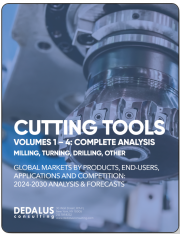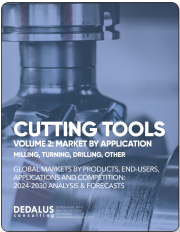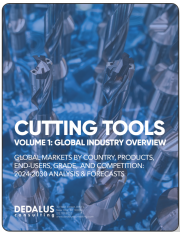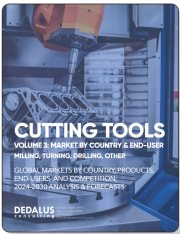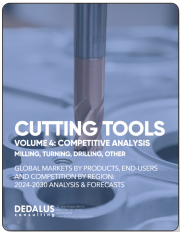
|
시장보고서
상품코드
1578805
세계의 PCD 절삭 공구 시장 : 공구 유형, 용도, 재료 유형, 최종 사용자, 공구 기능별 예측(2025-2030년)PCD Cutting Tools Market by Tool Type (Drilling Tools, Milling Tools, Reaming Tools), Application (Aerospace, Automotive, Electronics), Material Type, End User, Tool Features - Global Forecast 2025-2030 |
||||||
PCD 절삭 공구 시장은 2023년에 54억 8,000만 달러로 평가되었고, 2024년에는 61억 6,000만 달러에 도달할 것으로 예측되며, 복합 연간 성장률(CAGR) 14.84%로 성장하여 2030년에는 144억 5,000만 달러에 달할 것으로 예상됩니다.
다결정 다이아몬드(PCD) 절삭 공구는 자동차, 항공우주, 전자, 에너지 분야 등 고정밀 가공과 탁월한 내구성이 요구되는 산업에 필수적입니다. PCD 절삭 공구의 정의에는 드릴, 밀, 인서트를 포함한 기계 가공 응용 분야에 사용되는 모든 공구가 포함되어 있으며 인성과 수명을 향상시키기 위해 다결정 다이아몬드가 칩에 사용됩니다. 이러한 공구의 필요성은 고온 하에서도 예리함을 유지하고 내마모성이 우수하므로 빈번한 공구 교환에 따른 다운타임과 비용을 절감할 수 있다는 점에 있습니다. 용도는 비철금속, 복합재, 연마재에 대한 드릴링부터 연삭까지 다양하며, 모두 생산 라인에서 높은 효율성과 일관성이 요구됩니다.
| 주요 시장 통계 | |
|---|---|
| 기준년(2023) | 54억 8,000만 달러 |
| 예측년(2024) | 61억 6,000만 달러 |
| 예측년(2030) | 144억 5,000만 달러 |
| 복합 연간 성장률(CAGR)(%) | 14.84% |
시장의 성장은 PCD 공구와 같은 고급 가공 솔루션이 필요한 경량의 내구성 소재에 대한 자동차 및 항공우주 부문 수요 증가에 크게 영향을 받고 있습니다. 또한 연비 향상을 추진하는 환경 규제도 이 수요를 뒷받침하고 있습니다. 게다가 기술의 급속한 진보와 제조의 자동화가 진행되고, 디지털화와 스마트 매뉴팩처링이 극히 중요한 변화가 되어 새로운 길이 열리고 있습니다. 잠재적인 비즈니스 기회로는 산업화가 진행되는 신흥 시장으로의 진출과 PCD의 장수명 특성을 활용할 수 있는 지속 가능한 제조 공정에 대한 투자 등이 있습니다.
그러나 시장은 초기 투자 비용의 높이와 이러한 첨단 도구 제조 공정의 복잡성과 같은 과제에 직면하고 있습니다. 또한 저렴하지만 다른 고성능 절삭 공구와의 경쟁도 한계를 가져옵니다. 기술 혁신과 관련하여, PCD 제조의 비용 효율성 개선, 새로운 복합재료 구성 개발, 예측 보전 및 전체 프로세스 최적화를 위한 IoT 통합에 연구가 집중될 수 있습니다. 시장 경쟁은 치열하고 기술 주도형이기 때문에 한 걸음 더 나아가려면 지속적인 연구 개발이 필요합니다. 나노다이아몬드의 응용과 재활용 과정의 강화 등 특정 분야를 파악하고 투자함으로써 미래의 과제에 대한 합리적인 솔루션을 제공하고 정밀 산업의 진화하는 요구에 부응할 수 있습니다.
시장 역학: 빠르게 진화하는 PCD 절삭 공구 시장의 주요 시장 인사이트 공개
PCD 절삭 공구 시장은 수요 및 공급의 역동적인 상호 작용에 의해 변모하고 있습니다. 이러한 시장 역학의 진화를 이해함으로써 기업은 충분한 정보를 바탕으로 투자결정, 전략적 의사결정, 새로운 비즈니스 기회를 획득할 수 있습니다. 이러한 동향을 종합적으로 파악함으로써 기업은 정치적, 지리적, 기술적, 사회적, 경제적 영역에 걸친 다양한 리스크를 경감할 수 있을 뿐만 아니라 소비자 행동과 그것이 제조 비용 또는 구매 동향에 미치는 영향을보다 명확하게 이해할 수 있습니다.
- 시장 성장 촉진요인
- 정밀 제조 기술의 진보에 의한 다결정 다이아몬드 공구의 용도 확대
- 자동차 및 항공우주 분야에 있어서의 고성능 절삭 공구 수요 증가
- Additive Manufacturing의 채용 증가에 의한 PCD 절삭 공구의 기술 혁신 촉진
- 제조업에 있어서의 재료 낭비의 삭감과 공구 수명의 연장의 중시의 고조
- 시장 성장 억제요인
- 원재료 가격의 변동이 PCD 절삭 공구 시장의 수익성에 영향
- 초기 투자의 높이가 중소기업의 PCD 절삭 공구 시장에의 진입을 방해한다
- 시장 기회
- PCD 절삭 공구의 뛰어난 성능을 실현하는 고도 프로세스 제어(APC)의 도입
- PCD 절삭 공구의 장수명화와 효율화를 위한 코팅 기술의 혁신
- PCD 절삭 공구를 사용한 정밀 제조를 위한 인공지능과 머신러닝의 통합
- 시장의 과제
- PCD 절삭 공구에 특화된 진보를 위한 교육이나 트레이닝이 시장에 부족하다
- PCD 절삭 공구 시장의 확장성을 제한하는 고비용과 한정된 원재료의 이용가능성
Porter's Five Forces: PCD 절삭 공구 시장을 탐색하는 전략 도구
Porter's Five Forces Framework는 PCD 절삭 공구 시장 경쟁 구도를 이해하는 중요한 도구입니다. Porter's Five Forces Framework는 기업의 경쟁력을 평가하고 전략적 기회를 탐구하는 명확한 기술을 제공합니다. 이 프레임워크는 기업이 시장 내 세력도를 평가하고 신규 사업의 수익성을 결정하는 데 도움이 됩니다. 이러한 통찰을 통해 기업은 자사의 강점을 활용하고, 약점을 해결하고, 잠재적인 과제를 피할 수 있으며, 보다 강인한 시장에서의 포지셔닝을 보장할 수 있습니다.
PESTLE 분석 : PCD 절삭 공구 시장에서 외부로부터의 영향 파악
외부 거시 환경 요인은 PCD 절삭 공구 시장의 성과 역학을 형성하는데 매우 중요한 역할을 합니다. 정치적, 경제적, 사회적, 기술적, 법적, 환경적 요인 분석은 이러한 영향을 탐색하는 데 필요한 정보를 제공합니다. PESTLE 요인을 조사함으로써 기업은 잠재적인 위험과 기회를 더 잘 이해할 수 있습니다. 이 분석을 통해 기업은 규제, 소비자 선호, 경제 동향의 변화를 예측하고 앞으로 예상되는 적극적인 의사 결정을 할 준비를 할 수 있습니다.
시장 점유율 분석 PCD 절삭 공구 시장 경쟁 구도 파악
PCD 절삭 공구 시장의 상세한 시장 점유율 분석을 통해 공급업체의 성과를 종합적으로 평가할 수 있습니다. 기업은 수익, 고객 기반, 성장률 등 주요 지표를 비교하여 경쟁 포지셔닝을 밝힐 수 있습니다. 이 분석을 통해 시장 집중, 단편화 및 통합 동향을 밝혀내고 공급업체는 경쟁이 치열해지면서 자신의 입지를 높이는 전략적 의사 결정을 내리는 데 필요한 지식을 얻을 수 있습니다.
FPNV 포지셔닝 매트릭스 PCD 절삭 공구 시장에서 공급업체의 성능 평가
FPNV 포지셔닝 매트릭스는 PCD 절삭 공구 시장에서 공급업체를 평가하는 중요한 도구입니다. 이 행렬을 통해 비즈니스 조직은 공급업체의 비즈니스 전략과 제품 만족도를 기준으로 평가하여 목표에 맞는 충분한 정보를 바탕으로 의사 결정을 내릴 수 있습니다. 네 가지 사분면을 통해 공급업체를 명확하고 정확하게 부문화하고 전략 목표에 가장 적합한 파트너 및 솔루션을 파악할 수 있습니다.
전략 분석 및 권장 PCD 절삭 공구 시장에서 성공에 대한 길을 그립니다.
PCD 절삭 공구 시장의 전략 분석은 시장에서의 프레즌스 강화를 목표로 하는 기업에 필수적입니다. 주요 자원, 역량 및 성과 지표를 검토함으로써 기업은 성장 기회를 파악하고 개선을 위해 노력할 수 있습니다. 이러한 접근 방식을 통해 경쟁 구도에서 과제를 극복하고 새로운 비즈니스 기회를 활용하여 장기적인 성공을 거둘 수 있는 체제를 구축할 수 있습니다.
이 보고서는 주요 관심 분야를 포괄하는 시장의 종합적인 분석을 제공합니다.
1. 시장 침투 : 현재 시장 환경의 상세한 검토, 주요 기업의 광범위한 데이터, 시장 도달범위 및 전반적인 영향력 평가.
2. 시장 개척도 : 신흥 시장의 성장 기회를 파악하고 기존 분야의 확장 가능성을 평가하며 미래 성장을 위한 전략적 로드맵을 제공합니다.
3. 시장 다양화 : 최근 제품 출시, 미개척 지역, 업계의 주요 진보, 시장을 형성하는 전략적 투자를 분석합니다.
4. 경쟁 평가 및 정보 : 경쟁 구도를 철저히 분석하여 시장 점유율, 사업 전략, 제품 포트폴리오, 인증, 규제 당국 승인, 특허 동향, 주요 기업의 기술 진보 등을 검증합니다.
5. 제품 개발 및 혁신 : 미래 시장 성장을 가속할 것으로 예상되는 최첨단 기술, R&D 활동, 제품 혁신을 강조합니다.
또한 이해관계자가 충분한 정보를 바탕으로 의사 결정을 내리는 데 도움이 되는 중요한 질문에 응답합니다.
1. 현재 시장 규모와 향후 성장 예측은?
2. 최고의 투자 기회를 제공하는 제품, 부문 및 지역은 어디입니까?
3. 시장을 형성하는 주요 기술 동향과 규제의 영향은?
4. 주요 벤더의 시장 점유율과 경쟁 포지션은?
5. 벤더 시장 진입, 철수 전략의 원동력이 되는 수익원과 전략적 기회는 무엇인가?
목차
제1장 서문
제2장 조사 방법
제3장 주요 요약
제4장 시장 개요
제5장 시장 인사이트
- 시장 역학
- 성장 촉진요인
- 정밀 제조에 있어서의 기술의 진보에 의해 다결정 다이아몬드 공구의 용도가 확대
- 자동차 및 항공우주 분야에서의 고성능 절삭 공구 수요 증가
- 적층 조형의 채용 증가가 PCD 절삭 공구에 있어서의 혁신을 추진
- 제조업에 있어서의 재료의 낭비의 삭감과 공구 수명의 연장에의 중점의 고조
- 억제요인
- 원재료 가격의 변동이 수익성에 영향 PCD 절삭 공구 시장
- 초기 투자액이 높기 때문에 중소기업의 진입이 곤란 PCD 절삭 공구 시장
- 기회
- 뛰어난 성능을 실현하기 위해 PCD 절삭 공구에 고급 공정 제어(APC)를 구현
- PCD 절삭 공구에서의 내구성과 효율성을 높이는 코팅 기술의 혁신
- PCD 절삭 공구를 사용한 정밀 제조를 위한 인공지능과 머신러닝의 통합
- 과제
- 시장에는 PCD 절삭 공구에 특화된 진보를 위한 교육과 트레이닝이 부족하다
- 원재료의 고비용과 입수의 제한에 의해 PCD 절삭 공구 시장
- 성장 촉진요인
- 시장 세분화 분석
- Porter's Five Forces 분석
- PESTEL 분석
- 정치적
- 경제
- 사교
- 기술적
- 법률상
- 환경
제6장 PCD 절삭 공구 시장 툴 유형별
- 드릴링 공구
- 스페이드 드릴
- 트위스트 드릴
- 밀링 가공 공구
- 엔드밀
- 페이스 밀
- 숄더 밀
- 리머 공구
- 헬리컬 플루트 리마
- 스트레이트 플루트 리머
- 선삭 공구
- 홈 삽입 공구
- 선삭 인서트
제7장 PCD 절삭 공구 시장 : 용도별
- 항공우주
- 기체 부품
- 엔진 부품
- 자동차
- 바디 컴포넌트
- 섀시 부품
- 파워트레인 컴포넌트
- 일렉트로닉스
- 회로 기판
- 마이크로칩
- 의학
- 치과용기구
- 임플란트
- 수술기구
제8장 PCD 절삭 공구 시장 소재 유형별
- PCD 코팅
- PCD 칩
- 솔리드 PCD
제9장 PCD 절삭 공구 시장 : 최종 사용자별
- 대기업
- 항공우주 OEM
- 자동차 OEM
- 중소기업
- 작업 숍
- 전문 제조업체
제10장 PCD 절삭 공구 시장 툴 기능별
- 냉각제 통과
- 비냉각 스루
제11장 아메리카의 PCD 절삭 공구 시장
- 아르헨티나
- 브라질
- 캐나다
- 멕시코
- 미국
제12장 아시아태평양의 PCD 절삭 공구 시장
- 호주
- 중국
- 인도
- 인도네시아
- 일본
- 말레이시아
- 필리핀
- 싱가포르
- 한국
- 대만
- 태국
- 베트남
제13장 유럽, 중동 및 아프리카의 PCD 절삭 공구 시장
- 덴마크
- 이집트
- 핀란드
- 프랑스
- 독일
- 이스라엘
- 이탈리아
- 네덜란드
- 나이지리아
- 노르웨이
- 폴란드
- 카타르
- 러시아
- 사우디아라비아
- 남아프리카
- 스페인
- 스웨덴
- 스위스
- 터키
- 아랍에미리트(UAE)
- 영국
제14장 경쟁 구도
- 시장 점유율 분석(2023년)
- FPNV 포지셔닝 매트릭스(2023년)
- 경쟁 시나리오 분석
- 전략 분석과 제안
기업 목록
- Advent Tool & Manufacturing, Inc.
- BIG KAISER Precision Tooling Inc.
- CeramTec GmbH
- Fullerton Tool Company Inc.
- Guhring KG
- Ingersoll Cutting Tool Company
- ISCAR Ltd.
- KennaMetal Inc
- Kyocera Corporation
- LMT Onsrud LP
- Mapal Dr. Kress KG
- Mitsubishi Materials Corporation
- NS Tool Co., Ltd.
- RobbJack Corporation
- Sandvik AB
- Seco Tools AB
- Sumitomo Electric Industries, Ltd.
- Union Tool Co.
- Walter AG
- Yamawa Mfg. Co., Ltd.
The PCD Cutting Tools Market was valued at USD 5.48 billion in 2023, expected to reach USD 6.16 billion in 2024, and is projected to grow at a CAGR of 14.84%, to USD 14.45 billion by 2030.
Polycrystalline Diamond (PCD) cutting tools are indispensable in industries requiring high-precision machining and exceptional durability, such as automotive, aerospace, electronics, and energy sectors. The definition of PCD cutting tools encompasses any tool used in machining applications, including drills, mills, and inserts, which are tipped with polycrystalline diamond to enhance toughness and life span. The necessity for these tools is driven by their ability to maintain sharpness and resist wear even at high temperatures, reducing downtime and costs associated with frequent tool changes. Applications range from drilling into non-ferrous metals, composites, and abrasive materials to grinding, all demanding high efficiency and consistency in production lines.
| KEY MARKET STATISTICS | |
|---|---|
| Base Year [2023] | USD 5.48 billion |
| Estimated Year [2024] | USD 6.16 billion |
| Forecast Year [2030] | USD 14.45 billion |
| CAGR (%) | 14.84% |
The market's growth is significantly influenced by increased demand from the automotive and aerospace sectors for lightweight and durable materials necessitating advanced machining solutions like PCD tools. Environmental regulations pushing for better fuel efficiency also feed into this demand. Moreover, rapid advancements in technology and increased automation in manufacturing are opening up new avenues, with digitalization and smart manufacturing being pivotal changes in the landscape. Potential opportunities include expanding into emerging markets where industrialization is on the rise, and investing in sustainable manufacturing processes that can leverage PCD's long-lasting properties.
However, the market faces challenges like high initial investment costs and the complexity of the manufacturing process for these advanced tools. Additionally, competition from other high-performance, albeit cheaper, cutting tools poses a limitation. As far as innovation goes, research could focus on improving the cost-efficiency of PCD production, developing new composite configurations, and integrating IoT for predictive maintenance and overall process optimization. The nature of the market is highly competitive and technology-driven, requiring continuous R&D to stay ahead. Identifying and investing in specific areas like nanodiamond applications or enhancing recycling processes could offer streamlined solutions for future challenges, catering to the evolving needs of precision industries.
Market Dynamics: Unveiling Key Market Insights in the Rapidly Evolving PCD Cutting Tools Market
The PCD Cutting Tools Market is undergoing transformative changes driven by a dynamic interplay of supply and demand factors. Understanding these evolving market dynamics prepares business organizations to make informed investment decisions, refine strategic decisions, and seize new opportunities. By gaining a comprehensive view of these trends, business organizations can mitigate various risks across political, geographic, technical, social, and economic domains while also gaining a clearer understanding of consumer behavior and its impact on manufacturing costs and purchasing trends.
- Market Drivers
- Technological advancements in precision manufacturing enhancing polycrystalline diamond tool applications
- Growing demand for high-performance cutting tools in automotive and aerospace sectors
- Increasing adoption of additive manufacturing driving innovation in PCD cutting tools
- Rising emphasis on reducing material wastage and increasing tool life in manufacturing industries
- Market Restraints
- Volatility in raw material prices impacting the profitability of PCD cutting tools market
- High initial investment hampers small and medium enterprises from entering the PCD cutting tools market
- Market Opportunities
- Implementation of advanced process control (APC) in pcd cutting tools for superior performance
- Innovations in coating technologies for longevity and efficiency in pcd cutting tools
- Integration of artificial intelligence and machine learning for precision manufacturing using pcd cutting tools
- Market Challenges
- Market lacks education and training for advancements specific to PCD cutting tools
- High cost and limited availability of raw materials restrict scalability in the PCD cutting tools market
Porter's Five Forces: A Strategic Tool for Navigating the PCD Cutting Tools Market
Porter's five forces framework is a critical tool for understanding the competitive landscape of the PCD Cutting Tools Market. It offers business organizations with a clear methodology for evaluating their competitive positioning and exploring strategic opportunities. This framework helps businesses assess the power dynamics within the market and determine the profitability of new ventures. With these insights, business organizations can leverage their strengths, address weaknesses, and avoid potential challenges, ensuring a more resilient market positioning.
PESTLE Analysis: Navigating External Influences in the PCD Cutting Tools Market
External macro-environmental factors play a pivotal role in shaping the performance dynamics of the PCD Cutting Tools Market. Political, Economic, Social, Technological, Legal, and Environmental factors analysis provides the necessary information to navigate these influences. By examining PESTLE factors, businesses can better understand potential risks and opportunities. This analysis enables business organizations to anticipate changes in regulations, consumer preferences, and economic trends, ensuring they are prepared to make proactive, forward-thinking decisions.
Market Share Analysis: Understanding the Competitive Landscape in the PCD Cutting Tools Market
A detailed market share analysis in the PCD Cutting Tools Market provides a comprehensive assessment of vendors' performance. Companies can identify their competitive positioning by comparing key metrics, including revenue, customer base, and growth rates. This analysis highlights market concentration, fragmentation, and trends in consolidation, offering vendors the insights required to make strategic decisions that enhance their position in an increasingly competitive landscape.
FPNV Positioning Matrix: Evaluating Vendors' Performance in the PCD Cutting Tools Market
The Forefront, Pathfinder, Niche, Vital (FPNV) Positioning Matrix is a critical tool for evaluating vendors within the PCD Cutting Tools Market. This matrix enables business organizations to make well-informed decisions that align with their goals by assessing vendors based on their business strategy and product satisfaction. The four quadrants provide a clear and precise segmentation of vendors, helping users identify the right partners and solutions that best fit their strategic objectives.
Strategy Analysis & Recommendation: Charting a Path to Success in the PCD Cutting Tools Market
A strategic analysis of the PCD Cutting Tools Market is essential for businesses looking to strengthen their global market presence. By reviewing key resources, capabilities, and performance indicators, business organizations can identify growth opportunities and work toward improvement. This approach helps businesses navigate challenges in the competitive landscape and ensures they are well-positioned to capitalize on newer opportunities and drive long-term success.
Key Company Profiles
The report delves into recent significant developments in the PCD Cutting Tools Market, highlighting leading vendors and their innovative profiles. These include Advent Tool & Manufacturing, Inc., BIG KAISER Precision Tooling Inc., CeramTec GmbH, Fullerton Tool Company Inc., Guhring KG, Ingersoll Cutting Tool Company, ISCAR Ltd., KennaMetal Inc, Kyocera Corporation, LMT Onsrud LP, Mapal Dr. Kress KG, Mitsubishi Materials Corporation, NS Tool Co., Ltd., RobbJack Corporation, Sandvik AB, Seco Tools AB, Sumitomo Electric Industries, Ltd., Union Tool Co., Walter AG, and Yamawa Mfg. Co., Ltd..
Market Segmentation & Coverage
This research report categorizes the PCD Cutting Tools Market to forecast the revenues and analyze trends in each of the following sub-markets:
- Based on Tool Type, market is studied across Drilling Tools, Milling Tools, Reaming Tools, and Turning Tools. The Drilling Tools is further studied across Spade Drills and Twist Drills. The Milling Tools is further studied across End Mills, Face Mills, and Shoulder Mills. The Reaming Tools is further studied across Helical Flute Reamers and Straight Flute Reamers. The Turning Tools is further studied across Grooving Tools and Turning Inserts.
- Based on Application, market is studied across Aerospace, Automotive, Electronics, and Medical. The Aerospace is further studied across Airframe Components and Engine Components. The Automotive is further studied across Body Components, Chassis Components, and Powertrain Components. The Electronics is further studied across Circuit Boards and Microchips. The Medical is further studied across Dental Tools, Implants, and Surgical Instruments.
- Based on Material Type, market is studied across PCD Coated, PCD Tipped, and Solid PCD.
- Based on End User, market is studied across Large Enterprises and SMEs. The Large Enterprises is further studied across Aerospace OEMs and Automotive OEMs. The SMEs is further studied across Job Shops and Specialty Manufacturers.
- Based on Tool Features, market is studied across Coolant Through and Non-Coolant Through.
- Based on Region, market is studied across Americas, Asia-Pacific, and Europe, Middle East & Africa. The Americas is further studied across Argentina, Brazil, Canada, Mexico, and United States. The United States is further studied across California, Florida, Illinois, New York, Ohio, Pennsylvania, and Texas. The Asia-Pacific is further studied across Australia, China, India, Indonesia, Japan, Malaysia, Philippines, Singapore, South Korea, Taiwan, Thailand, and Vietnam. The Europe, Middle East & Africa is further studied across Denmark, Egypt, Finland, France, Germany, Israel, Italy, Netherlands, Nigeria, Norway, Poland, Qatar, Russia, Saudi Arabia, South Africa, Spain, Sweden, Switzerland, Turkey, United Arab Emirates, and United Kingdom.
The report offers a comprehensive analysis of the market, covering key focus areas:
1. Market Penetration: A detailed review of the current market environment, including extensive data from top industry players, evaluating their market reach and overall influence.
2. Market Development: Identifies growth opportunities in emerging markets and assesses expansion potential in established sectors, providing a strategic roadmap for future growth.
3. Market Diversification: Analyzes recent product launches, untapped geographic regions, major industry advancements, and strategic investments reshaping the market.
4. Competitive Assessment & Intelligence: Provides a thorough analysis of the competitive landscape, examining market share, business strategies, product portfolios, certifications, regulatory approvals, patent trends, and technological advancements of key players.
5. Product Development & Innovation: Highlights cutting-edge technologies, R&D activities, and product innovations expected to drive future market growth.
The report also answers critical questions to aid stakeholders in making informed decisions:
1. What is the current market size, and what is the forecasted growth?
2. Which products, segments, and regions offer the best investment opportunities?
3. What are the key technology trends and regulatory influences shaping the market?
4. How do leading vendors rank in terms of market share and competitive positioning?
5. What revenue sources and strategic opportunities drive vendors' market entry or exit strategies?
Table of Contents
1. Preface
- 1.1. Objectives of the Study
- 1.2. Market Segmentation & Coverage
- 1.3. Years Considered for the Study
- 1.4. Currency & Pricing
- 1.5. Language
- 1.6. Stakeholders
2. Research Methodology
- 2.1. Define: Research Objective
- 2.2. Determine: Research Design
- 2.3. Prepare: Research Instrument
- 2.4. Collect: Data Source
- 2.5. Analyze: Data Interpretation
- 2.6. Formulate: Data Verification
- 2.7. Publish: Research Report
- 2.8. Repeat: Report Update
3. Executive Summary
4. Market Overview
5. Market Insights
- 5.1. Market Dynamics
- 5.1.1. Drivers
- 5.1.1.1. Technological advancements in precision manufacturing enhancing polycrystalline diamond tool applications
- 5.1.1.2. Growing demand for high-performance cutting tools in automotive and aerospace sectors
- 5.1.1.3. Increasing adoption of additive manufacturing driving innovation in PCD cutting tools
- 5.1.1.4. Rising emphasis on reducing material wastage and increasing tool life in manufacturing industries
- 5.1.2. Restraints
- 5.1.2.1. Volatility in raw material prices impacting the profitability of PCD cutting tools market
- 5.1.2.2. High initial investment hampers small and medium enterprises from entering the PCD cutting tools market
- 5.1.3. Opportunities
- 5.1.3.1. Implementation of advanced process control (APC) in pcd cutting tools for superior performance
- 5.1.3.2. Innovations in coating technologies for longevity and efficiency in pcd cutting tools
- 5.1.3.3. Integration of artificial intelligence and machine learning for precision manufacturing using pcd cutting tools
- 5.1.4. Challenges
- 5.1.4.1. Market lacks education and training for advancements specific to PCD cutting tools
- 5.1.4.2. High cost and limited availability of raw materials restrict scalability in the PCD cutting tools market
- 5.1.1. Drivers
- 5.2. Market Segmentation Analysis
- 5.3. Porter's Five Forces Analysis
- 5.3.1. Threat of New Entrants
- 5.3.2. Threat of Substitutes
- 5.3.3. Bargaining Power of Customers
- 5.3.4. Bargaining Power of Suppliers
- 5.3.5. Industry Rivalry
- 5.4. PESTLE Analysis
- 5.4.1. Political
- 5.4.2. Economic
- 5.4.3. Social
- 5.4.4. Technological
- 5.4.5. Legal
- 5.4.6. Environmental
6. PCD Cutting Tools Market, by Tool Type
- 6.1. Introduction
- 6.2. Drilling Tools
- 6.2.1. Spade Drills
- 6.2.2. Twist Drills
- 6.3. Milling Tools
- 6.3.1. End Mills
- 6.3.2. Face Mills
- 6.3.3. Shoulder Mills
- 6.4. Reaming Tools
- 6.4.1. Helical Flute Reamers
- 6.4.2. Straight Flute Reamers
- 6.5. Turning Tools
- 6.5.1. Grooving Tools
- 6.5.2. Turning Inserts
7. PCD Cutting Tools Market, by Application
- 7.1. Introduction
- 7.2. Aerospace
- 7.2.1. Airframe Components
- 7.2.2. Engine Components
- 7.3. Automotive
- 7.3.1. Body Components
- 7.3.2. Chassis Components
- 7.3.3. Powertrain Components
- 7.4. Electronics
- 7.4.1. Circuit Boards
- 7.4.2. Microchips
- 7.5. Medical
- 7.5.1. Dental Tools
- 7.5.2. Implants
- 7.5.3. Surgical Instruments
8. PCD Cutting Tools Market, by Material Type
- 8.1. Introduction
- 8.2. PCD Coated
- 8.3. PCD Tipped
- 8.4. Solid PCD
9. PCD Cutting Tools Market, by End User
- 9.1. Introduction
- 9.2. Large Enterprises
- 9.2.1. Aerospace OEMs
- 9.2.2. Automotive OEMs
- 9.3. SMEs
- 9.3.1. Job Shops
- 9.3.2. Specialty Manufacturers
10. PCD Cutting Tools Market, by Tool Features
- 10.1. Introduction
- 10.2. Coolant Through
- 10.3. Non-Coolant Through
11. Americas PCD Cutting Tools Market
- 11.1. Introduction
- 11.2. Argentina
- 11.3. Brazil
- 11.4. Canada
- 11.5. Mexico
- 11.6. United States
12. Asia-Pacific PCD Cutting Tools Market
- 12.1. Introduction
- 12.2. Australia
- 12.3. China
- 12.4. India
- 12.5. Indonesia
- 12.6. Japan
- 12.7. Malaysia
- 12.8. Philippines
- 12.9. Singapore
- 12.10. South Korea
- 12.11. Taiwan
- 12.12. Thailand
- 12.13. Vietnam
13. Europe, Middle East & Africa PCD Cutting Tools Market
- 13.1. Introduction
- 13.2. Denmark
- 13.3. Egypt
- 13.4. Finland
- 13.5. France
- 13.6. Germany
- 13.7. Israel
- 13.8. Italy
- 13.9. Netherlands
- 13.10. Nigeria
- 13.11. Norway
- 13.12. Poland
- 13.13. Qatar
- 13.14. Russia
- 13.15. Saudi Arabia
- 13.16. South Africa
- 13.17. Spain
- 13.18. Sweden
- 13.19. Switzerland
- 13.20. Turkey
- 13.21. United Arab Emirates
- 13.22. United Kingdom
14. Competitive Landscape
- 14.1. Market Share Analysis, 2023
- 14.2. FPNV Positioning Matrix, 2023
- 14.3. Competitive Scenario Analysis
- 14.4. Strategy Analysis & Recommendation
Companies Mentioned
- 1. Advent Tool & Manufacturing, Inc.
- 2. BIG KAISER Precision Tooling Inc.
- 3. CeramTec GmbH
- 4. Fullerton Tool Company Inc.
- 5. Guhring KG
- 6. Ingersoll Cutting Tool Company
- 7. ISCAR Ltd.
- 8. KennaMetal Inc
- 9. Kyocera Corporation
- 10. LMT Onsrud LP
- 11. Mapal Dr. Kress KG
- 12. Mitsubishi Materials Corporation
- 13. NS Tool Co., Ltd.
- 14. RobbJack Corporation
- 15. Sandvik AB
- 16. Seco Tools AB
- 17. Sumitomo Electric Industries, Ltd.
- 18. Union Tool Co.
- 19. Walter AG
- 20. Yamawa Mfg. Co., Ltd.






